
Gateway
|
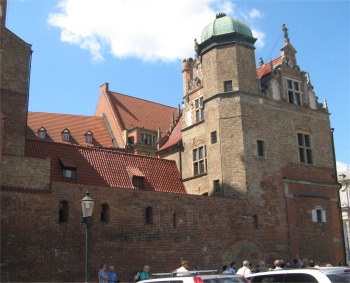
Torture House and Prison Tower
|
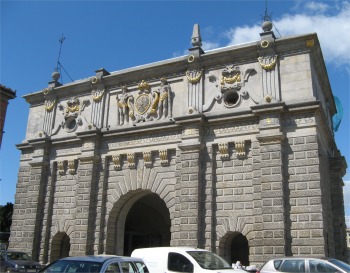
Upland Gate
|
After a lot of rain through the night, we popped our heads out around 05:30 and found a bright day. Shortly after 6am, we walked into town to catch a bus to Lebork, from where we would catch a train to Gdansk. the bus set off and travelled down back country lanes, picking up school kids on the way. We trundled through birch forests, meadows and cultivated green and pleasant lands, dotted with farmsteads and small villages.

Great Armoury
|
I gazed and wondered at the thought of how little this land had changed in the last 70 years. Then, the lands were not so pleasant. I was passing through an area which would have then seen "Death Marches" from the concentration camp at Stutthof, Janowice. After about an hour we reached Lebork, a sizeable town with ugly industrialised outskirts and a standard urban interior. At the train station, we were confronted with having to get a train to Wyentukow, and changing there to a train to Gdansk. We took this in our stride, and two hours later we were gliding through Gdynia, and then after a series of industrialised areas, we emerged from leafy suburbs into Gdansk station, a magnificent neo-Gothic construction.
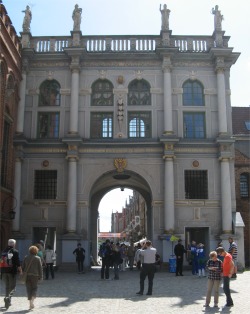
Golden Gate
|
We made doubly sure at the station what trains we could get back, and bought the return tickets. The return tickets cost twice as much, either because it was direct, it didn't have as many commuter stops, or it was more comfortable; we'll never know. Even though it was an express train, it still took the same length of time as the outward bound journey.
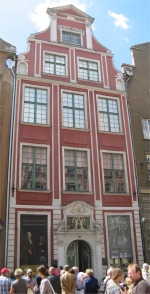
Uphagen House
|
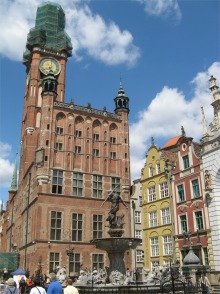
Town Hall of the Main City
|
Once sorted, we set about exploring the city, heading straight for the Old City. Our entry was by the Upland Gate, a richly sculpted 16th century stone gate which marked the beginning of the Royal Route. It was here that the high and mighty of the world were greeted by cheering crowds as they made their ceremonious entry into the city. Adjacent was the Gateway to Long Street. It was a mix of Gothic and Renaissance in style, and was at one time part of the medieval city fortifications. The Torture Tower was once used for public execution. Nearby was the imposing and ornate edifice of the Great Armoury, representing the most exquisite example of the Dutch Mannerism in Gdansk.

Silent Witnesses
|
Moving back towards Long Street, we passed the St George Fraternity Court, a rifle club built in the late 15th century in fashionable Flemish style. This brought us to the Golden Gate, a magnificent two storey high arch of triumph, built in the early 17th century to mark the entrance to the grand Long Street.

Artus Court and Neptune Fountain
|
Once through the arch, spread out before us was the main tourist thoroughfare of Long Street. Nothing had prepared me for the walk ahead along this pedestrianised way. It was throbbing with swarms of tourists, many from cruise ships, hovering around their guides and hanging onto every word, simultaneously snapping the architectural wonders around them before being herded off to their next stop.
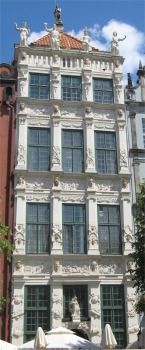
Golden House
|
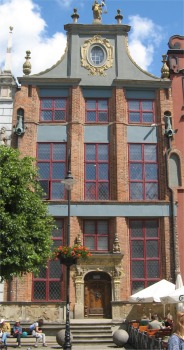
New Bench House
|
What struck me was how closely the architecture along the street resembled the Dutch style. The houses flanking the street originally belonged to the rich and influential Gdansk families. The grand facades competed with one another through an abundance of form and originality of decor. Outdoor cafes lined the street, jewelry stalls abounded, and numerous buskers graced the whole area. These weren't ordinary buskers, they were playing flutes, violins, guitars, and competently playing classical music. Alan was most impressed.
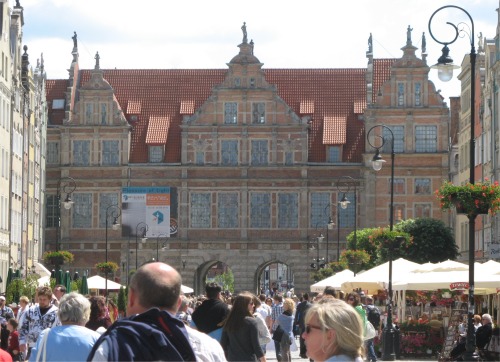
Green Gate
|
A short way down the street stood the Town Hall of the Main City, which served the authorities of the wealthy and mighty Gdansk. It was first erected in the 13th century. A major fire in the middle of the 16th century resulted in a rebuild in the Renaissance style.

Ornate Lamp
|
A hop, skip and jump away was Artus Court, the erection of which was inspired by the legendary King Arthur and the Knights of the Round Table. The edifice served as the representative offices of merchant guilds (called the Benches), rich artisans, and craftsmen. As such, it was an important centre of social and commercial life in old Gdansk.

Classical Musicians
|
Neighbouring Artus Court lay New Bench House. Its Baroque finish reflected the Gdansk-Dutch craft typically met in the local merchant residences.
In front of these buildings stood the 17th century Neptune Fountain, a symbol of Gdansk's bond with the sea and adding charm to the street. It also served as a backdrop for thousands of tourist posed photos.
Further down the street was the Golden House, one of the most beautiful buildings in the city. The sculpted ornamentation commissioned from Italy and transported to Gdansk by sea, was designed to adorn the front wall of the house. Unfortunately, the ship carrying the sculptures sank on the way. The facade was decorated with the pieces originally planned for the back yard wall.

Motlawa River with the Crane in the Centre
|
We were struck by the amount of Dutch style architecture around, and sought out an information office to inquire. Once we found an office that could communicate in English, we were told that the designs were purely Polish, any resemblance to Dutch styles were purely coincidental. We were also informed that a lot of the city was destroyed in the last war, and what we were looking at were exact replicas - amazing.

St Mary's Church
|
We exited Long Street at Green Gate, standing on the site of the earliest city gate, the Koga Gate. This delightful building was created in the Mannerist style just after the mid 16th century by builders from Amsterdam and Dresden. It was intended to be the royal residence for the monarchy visiting the city. Today, it is frequently used as an exhibition hall, and also houses the office of Lech Walesa, a Nobel Peace Prize winner and the first president of the Third Polish Republic.

Interior of St Mary's Church
|
Once through the gate, we arrived onto the front of the Motlawa. The river embankment (Long Embankment) was brimming with tourists, cafes and restaurants. Small pleasure cruises set off down the river from this quay, and mock galleons also transported folk into another time as they motored off down the waters too. Long canoes ploughed up and down the river, powered by a dozen or so tourist paddlers, with a drum pounding out a beat for the crew to strike to.
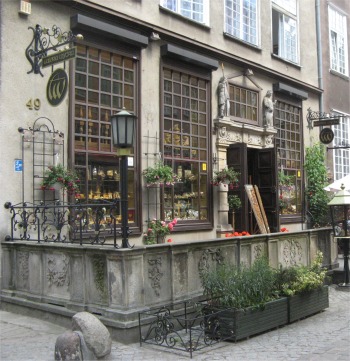
Typical Gallery in St Mary's Street
|
Just over the river, adjacent to the National Maritime Museum, the remains of a few derelict buildings stood, and an archeological dig was taking place too. The derelict parts looked out of place, so we asked a waiter what the area was used for. He laughed and said that some parties wanted the old rye storage houses retained for historical purposes. Others wanted it all demolished and redeveloped. The conflict had been ongoing for twenty years, and would probably continue for as long again. Nothing different from Britain really.

Close-up of Crane
|
A quick lunch by the river stood us in good stead for a short hike to St Mary's Church. Work on this enormous basilica started in 1343, and was finally completed in 1502, and is the largest European sacred structure constructed out of brick. The windows and spires soared into the sky, and the bell tower climbed even higher. To me, I found the exterior rather ugly: sparse, undecorated brick walls reaching to the sky, all a drab, rustic brown colour. The Gothic interior could not have been more different. All the walls were dazzling white, as were the exceptionally beautiful crystal vaults. The interior also housed a magnificent astronomical clock, built 1464-1470, and a copy of Hans Memling's "The Last Judgment" triptych. For masochistic purposes, we climbed up the 400 steps to the top of the 82m bell tower to get a panoramic view of the city. Peering down around us, evidence of the "Dutch" style of architecture was everywhere. To the north stretched the river out to the Baltic, passing the semi-idle shipyards. An urban sprawl stretched in the distance towards Gydnia, but to the south, green fields and forests were only a short distance from the city.
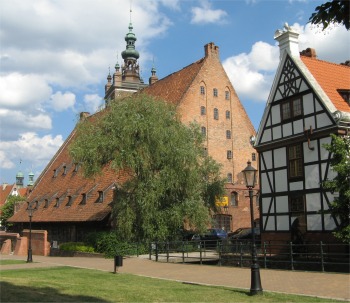
Grand Mill
|
We descended the steps and sauntered down St Mary's Street. This quiet lane and its romantic air had for centuries attracted artists. It was an exquisite example of the old Gdansk architecture. The houses with their characteristic entrance terraces and narrow, richly decorated facades were once dwelt in by wealthy merchants and goldsmiths. Nowadays, the street was an area hosting jewelry workshops and galleries, with unique Polish amber jewelry for sale. Gdansk cultivated its centuries old tradition of the world amber capital.

Town Hall of the Old City
|
The end of this charming street took us through medieval St Mary's Gate, back onto the Long Embankment. We wandered down the embankment to the Crane standing guard over the Motlawa River. It is the most characteristic and unmistaken symbol of Gdansk. Back in the Middle Ages, it was the largest port crane in Europe, handling cargo and erecting ship masts. The crane was operated by huge wooden drums inside the crane, driven by men walking inside them.
It was at this point where Alan and I went our separate ways; his legs were all spent after 400 step ups. He wandered off to the Maritime Museum, which turned out to be closed. I took a long hike down to the National Museum, which also turned out to be closed, despite the signs indicating that it should have been open.
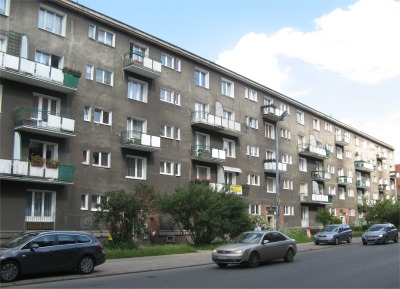
Typical Flats
|
I therefore made my way back up through the Old City to the Grand Mill. The Radunia Canal cutting across the Old City was a source of energy from as early as the Middle Ages. In 1350, the largest industrial structure of Medieval Europe, the Grand Mill with its characteristic huge gable roof, was erected on a tiny island formed where the canal splits. Today it accommodated a modern shopping centre.

There Must be a Story Behind This
|
A short walk up through a small park brought me to the Town Hall of the Old City, a romantic, almost filigree brick building with a slender turret. It is the best specimen of Mannerism in the city's architecture with its air closest to the Dutch original. It was also a surviving witness to a peculiar phenomenon in the local history: in days gone by, Gdansk was split into two areas, each with its own authorities, hence two town halls.
I just had time left to hike up past flats through the more modern part of the city to the "Roads to Freedom" exhibition. This fascinating multimedia exhibition gave an account of Polish history between 1956-89. The introduction inside the museum showed a reconstruction of a typical grocery store of the 1920s. Then, people would queue up outside such stores well before dawn, only to find that when the shop opened there might be just a couple of dozen eggs, a slab of cheese, and a few old sausages for the whole queue. Peculiarly, vinegar was one of the few goods available on a daily basis. Another section of the museum told the story of the struggles in other Soviet bloc countries such as Czechoslovakia, Hungary and East Berlin. It was on the premises of the former Lenin Shipyard in Gdansk that Solidarnosc was born in August 1980. This social and political movement gave hope to the Polish people, the hope that their dream of independence would become a reality. The 18-day strike of August 1980, which ended in an agreement between strikers and the authorities, became the symbolic date of the decline of communism in Europe. These events initiated the process of liberation from communist regimes in many countries.
The exhibits included two famous plywood boards containing 21 hand-written demands made during the August 1980 strikes.
After the strikes, martial law was declared, which lasted from the end of 1981 to mid 1984. Films were shown of street fights between dissenters and the authority representatives, and accounts given of the oppression suffered by the Polish people, the show trials and sinister communist propaganda. English translations were available for all the text, for which I thanked the curator when I left. I would recommend anyone interested in the Polish struggle to visit this museum.
I got back to the station to meet up with Alan, and we got the train and bus back to Leba. It had been a most enjoyable and informative day in a lovely city.























